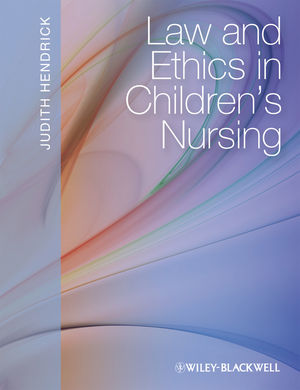Law and Ethics in Children's NursingISBN: 978-1-4051-6106-0
Paperback
266 pages
July 2010, Wiley-Blackwell
 |
||||||
Introduction.
1.1 What is law?
1.2 How the law is made – the sources of law.
1.3 Divisions within the law.
1.4 What is ethics?
1.5 Ethical toolkit.
1.6 The relationship between law and ethics.
References.
2 Childhood, Children’s Rights and Welfare.
Introduction.
2.1 Legal definitions of the child and childhood.
2.2 The relationship between law and childhood.
2.3 The nature of childhood.
2.4 Rights.
2.5 Children's rights.
2.6 Classification of children's rights.
2.7 Common themes.
2.8 Children and international law.
2.9 The welfare principle.
References.
3 Responsibility, Accountability and Negligence.
Introduction.
3.1 Beneficence: 'doing good'.
3.2 Non-maleficence: Avoiding harm and risk.
3.3 Moral responsibility and accountability.
3.4 Blame.
3.5 Ethical objectives of the law of negligence.
3.6 Legal responsibility and accountability.
3.7 The law of negligence.
3.8 Duty of care.
3.9 Breach of duty.
3.10 Causation.
3.11 Reform.
3.12 The relationship between law and ethics.
References.
4 Autonomy and Consent.
Introduction.
4.1 Autonomy.
4.2 Respecting and enhancing children's autonomy.
4.3 Challenging the pre-eminence of autonomy.
4.4 Paternalism.
4.5 The law of consent.
4.6 Essential requirements for consent to be legally valid.
4.7 Disagreements – the court's role.
4.8 Emergencies.
4.9 The relationship between law and ethics.
References.
5 Confidentiality, Medical Records and Data Protection.
Introduction.
5.1 Explaining confidentiality.
5.2 Children and confidentiality.
5.3 Ethical justifications for the duty of confidentiality.
5.4 The moral case for breaching confidentiality.
5.5 The law of confidentiality.
5.6 Children’s legal right to confidentiality.
5.7 Legal exceptions to the duty of confidentiality.
5.8 Access to records.
5.9 Relationship between law and ethics.
References.
6 Justice and Access to Health Care.
Introduction.
6.1 Children's health care services.
6.2 Defining terms.
6.3 Rationing health care resources.
6.4 Forms of rationing – how is health care rationed?
6.5 Distributing scarce resources – how to make ‘moral’ decisions.
6.6 Rationing and the law.
6.7 Using the law to gain access to treatment.
6.8 The relationship between law and ethics.
References.
7 Young People and Sexuality.
Introduction.
7.1 Abortion: Fetal rights.
7.2 Abortion: Maternal rights.
7.3 A compromise position.
7.4 The law of abortion.
7.5 When is an abortion legal?
7.6 Adolescents and the Abortion Act.
7.7 Other people's legal rights.
7.8 Sterilisation.
7.9 Family planning and the law.
7.10 The relationship between law and ethics.
References.
8 Birth and its Regulation.
Introduction.
8.1 Assisted reproduction.
8.2 Legal regulation of assisted reproduction.
8.3 Parentage.
8.4 Children's right to know their genetic parentage.
8.5 Surrogacy.
8.6 The legal regulation of surrogacy.
8.7 Pregnancy and childbirth.
8.8 Legal aspects of pregnancy.
8.9 Prenatal injuries.
8.10 The relationship between law and ethics.
References.
9 Research, Organ Donation and Tissue Transplantation.
Introduction.
9.1 Research.
9.2 Ethical considerations and principles.
9.3 Regulation of research.
9.4 Legal regulation of research.
9.5 Donation, storage and use of organs and tissue.
9.6 Human Tissue Act 2004.
9.7 Organ transplants from the dead.
9.8 The relationship between law and ethics.
References.
10 Mental Health.
Introduction.
10.1 Defining 'mental disorder'.
10.2 Incidence of mental disorders in young people.
10.3 Guidance governing children’s mental health.
10.4 The impact of a diagnosis of mental disorder.
10.5 Mental Health Act 1983.
10.6 Informal admission and treatment.
10.7 Compulsory admission – detaining young people against their will.
10.8 Treatments regulated by Part 4 of the MHA 1983.
10.9 Ethical issues.
10.10 Relationship between the law and ethics.
References.
11 Child Protection.
Introduction.
11.1 Development of children's welfare policies.
11.2 Models of state intervention.
11.3 Welfare services – family support and prevention.
11.4 Investigation of child abuse and neglect.
11.5 Protection of children in emergencies.
11.6 Long-term orders – care and supervision.
References.
12 Death, Dying and the Incurably Ill Child.
Introduction.
12.1 Definitions.
12.2 Is there an ethical obligation to prolong life?
12.3 Is there a moral distinction between killing and letting die?
12.4 Is there a moral distinction between intending and foreseeing a consequence?
12.5 What legal duties are owed at the end of life?
12.6 Is there a legal obligation to prolong life?
12.7 Is it lawful to withhold and withdraw life-saving treatment from children?
12.8 Can a child be deliberately killed?
12.9 What rights do parents have to determine treatment?
12.10 The court's role.
12.11 The relationship between law and ethics.
References.
Index.



